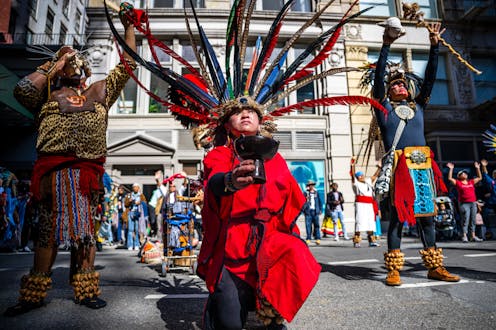What makes someone Indigenous?
- Written by Torivio Fodder, Indigenous Governance Program Manager and Professor of Practice, University of Arizona

While being Indigenous is a matter of ancestry and place, different Indigenous groups have their own cultures, traditions, languages and religions, much as these things may differ from country to country, state to state or even city to city today.
Political identity
Today, being Indigenous does not necessarily mean that your ancestors lived in the same place where you live right now. In fact, throughout history many Indigenous groups were removed from their traditional homelands[22] and forced to live somewhere else.
Most Indigenous groups who were forced off their lands did not want to leave. But settlers from elsewhere saw the lands and resources where Indigenous peoples lived and wanted them for their own countries. Often they used military force[23] to make Indigenous peoples leave their homes.
Many of those groups exist today as a type of government known as a tribe or Native nation. There are at least 574 tribes in the U.S. alone[25]. Like any other government, tribal governments make laws about how to live together peacefully, decide what it means to be a good citizen and plan for the future.
Together, those laws form a political community – an understanding about how all members of a Native nation agree to live and treat each other as part of the same Indigenous community.
So while being Indigenous has always been tied very closely to place, today it is also a matter of cultural and political identity. It helps to shape a person’s connection to their community and enables them to understand their place in history.
Hello, curious kids! Do you have a question you’d like an expert to answer? Ask an adult to send your question to CuriousKidsUS@theconversation.com[26]. Please tell us your name, age and the city where you live.
And since curiosity has no age limit – adults, let us know what you’re wondering, too. We won’t be able to answer every question, but we will do our best.
References
- ^ Curious Kids (theconversation.com)
- ^ curiouskidsus@theconversation.com (theconversation.com)
- ^ set sail from Spain (www.britannica.com)
- ^ little is known (kids.britannica.com)
- ^ the “New World” wasn’t new at all (www.loc.gov)
- ^ where their ancestors lived and how long they lived there (www.un.org)
- ^ 476 million Indigenous people (www.amnesty.org)
- ^ northern Canada (www.thecanadianencyclopedia.ca)
- ^ Alaska (www.nativefederation.org)
- ^ plains of the U.S. (kids.nationalgeographic.com)
- ^ Latin America (www.worldbank.org)
- ^ islands of the Pacific Ocean (lcipp.unfccc.int)
- ^ New Zealand (www.newzealand.com)
- ^ Comanche (comanchenation.com)
- ^ Kiowa (kiowatribe.org)
- ^ Cherokee (www.cherokee.org)
- ^ buffalo (theconversation.com)
- ^ tepees (www.britannica.com)
- ^ Taos Pueblo (taospueblo.com)
- ^ adobe (www.britannica.com)
- ^ Wolfgang Kaehler/LightRocket via Getty Images (www.gettyimages.com)
- ^ removed from their traditional homelands (www.wri.org)
- ^ military force (www.pbs.org)
- ^ AP Photo/Evan Vucci (newsroom.ap.org)
- ^ 574 tribes in the U.S. alone (www.usa.gov)
- ^ CuriousKidsUS@theconversation.com (theconversation.com)
Authors: Torivio Fodder, Indigenous Governance Program Manager and Professor of Practice, University of Arizona
Read more https://theconversation.com/what-makes-someone-indigenous-193072

